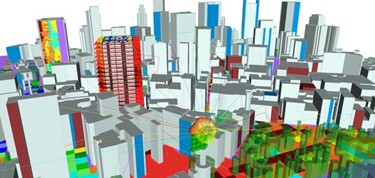5G Urban Small-Cell Analysis

With a tremendous increase in the number of connected devices and mobile data demand predicted over the next decade, the wireless communications industry is exploring new technologies to accommodate 5G wireless data systems, including MIMO (multiple-input, multiple-output) technology and millimeter wave frequency bands. One of the more complex environments for these technologies are urban small cells, where the prevalence of multipath and non-line-of-sight conditions leads to many challenges, particularly at higher frequencies.
With massive MIMO, large antenna arrays are able to provide data streams to multiple users within the same frequency band in a small cell. In an urban environment, signals can travel over many paths; this multipath causes the channel characteristics across an array of antennas to be extremely complex, particularly with devices in motion. Furthermore, at planned millimeter wave bands, higher path loss, atmospheric effects, and shadowing are even more pronounced in scenarios with significant urban clutter. Simulating these effects is critical for predicting MIMO system performance.
Simulating MIMO in Dense Urban Environments
Remcom offers a unique ray tracing capability for simulating MIMO antennas for 5G small cells in dense urban scenes. The MIMO version of Wireless InSite predicts accurate path data between each transmitting and receiving element with precision and reveals key channel characteristics in a timely manner. With optimizations that minimize runtime and memory constraints, Wireless InSite is able to efficiently simulate MIMO systems, including large arrays anticipated for millimeter wave MIMO systems situated in dense urban environments. New features for millimeter wave frequencies, including atmospheric losses and diffuse scattering from surfaces, offer additional accuracy to predict effects that become increasingly important at higher frequencies.
Communication systems analysis capabilities allow a user to predict how beamforming and spatial multiplexing can increase the signal-to-noise-ratio (SNR) or generate multiple data streams (e.g., MxN MIMO), increasing throughput in a coverage area or at the cell edge. Wireless InSite’s full access to path data allows users to truly understand the multipath environment. Post-processing capabilities for MIMO allow users to further process results to extract additional data such as the complex channel matrix or the angle spreads of arrival and departure. See our MIMO Beamforming, Spatial Multiplexing & Diversity page to find out more about Wireless InSite’s MIMO simulation capabilities.

FD-MIMO beamforming improves SNR in downtown Boston, increasing throughput across coverage area
